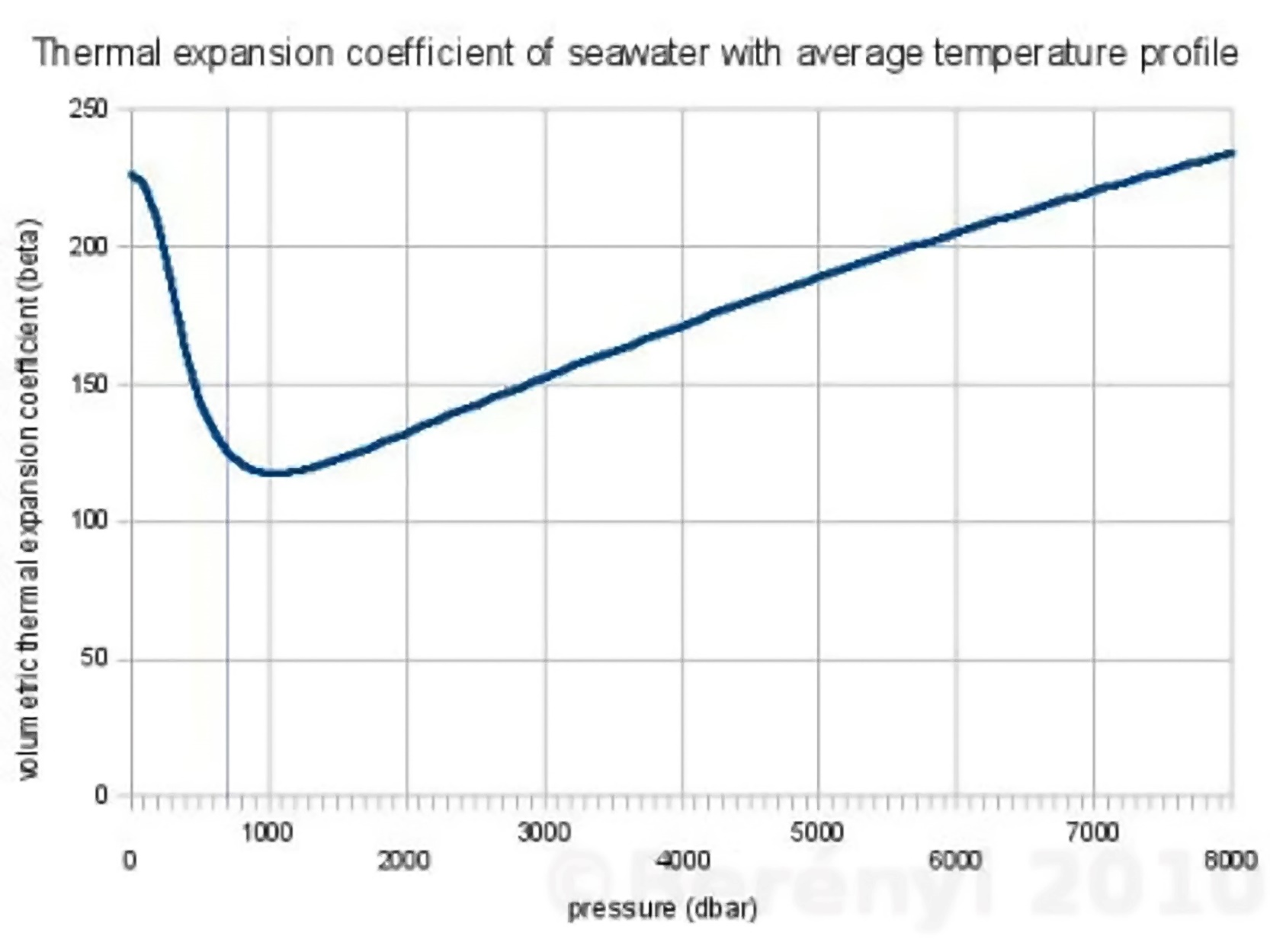"What's the use of having developed a science well enough to make predictions if, in the end, all we're willing to do is stand around and wait for them to come true?"
Jim Baird
”ocean heat content (OHC) and sea level rise are the most vital indicators of climate change,” Improved Quantification of the Rate of Ocean Warming.
Per the following graphic the thermal expansion coefficient of seawater at 1000 meters – 1000 dbar – is about half it is at the tropical surface.

Ocean heat sent with heat pipes to 1000 meters would produce half the thermal expansion that is currently occurring and heat sent to 1000 meters is unavailable to melt icecaps which are accounting for about 21% of the recorded sea level rise of the past two decades.
Heat sent to 1000 meters returns to the surface but on average will be at a depth of 500 meters which is still a quarter * 21% improvement over the sea level rise status quo.
To say nothing of the energy such a relocation through a heat engine can produce and the other climate benefits that are derived from cooling the surface.
“What’s the use of having developed a science well enough to make predictions if, in the end, all we’re willing to do is stand around and wait for them to come true?” F. Sherwood Rowland, Noble Laureate
Stephen Salter
Jim
The attached paper describes a way to pump surface water down without using fossil fuel. Apologies to people who already have it. Discovery Channel filmed a 1:100 scale tank model which was doing the equivalent of 1000 cubic metres a second.
Making VERY big floppy things with negative material costs needs new engineering ideas but I can send people a paper on how it could be done.
Stephen
Emeritus Professor of Engineering Design
School of Engineering
University of Edinburgh
Mayfield Road
Edinburgh EH9 3DW
Scotland
0131 662 1180
YouTube Jamie Taylor Power for Change
From: Jim Baird <jim....@gwmitigation.com>
Sent: 27 May 2023 19:01
To: 'Robert Chris' <robert...@gmail.com>; 'Tom Goreau' <gor...@globalcoral.org>; 'Ron Baiman' <rpba...@gmail.com>
Cc: 'Michael MacCracken' <mmac...@comcast.net>; Stephen Salter <S.Sa...@ed.ac.uk>; ''Eelco Rohling' via NOAC Meetings' <noac-m...@googlegroups.com>; healthy-planet-...@googlegroups.com; 'Planetary Restoration' <planetary-...@googlegroups.com>
Subject: "What's the use of having developed a science well enough to make predictions if, in the end, all we're willing to do is stand around and wait for them to come true?"
This email was sent to you by someone outside the University.
You should only click on links or attachments if you are certain that the email is genuine and the content is safe.
Jim Baird
Thanks Stephen:
Instead of pumping water, TG moves heat (Hurricane Fuel) via the phase changes of a working fluid in a heat pipe. The speed at which this transfer approaches the speed of sound but it can be decreased by making the diameter of the heat pipe greater. I calculate this would be in the range of 5 meters for a 1 gigawatt plant compared to a 10 meter cold water for a 100MW conventional OTEC plant.
The pressures involved in the heat pipe are about 10 bar using ammonia or 10 times that using CO2 as the working fluid so it would be pretty ridged and with CO2 the internal and external pressures would be equalized at 1000 meters.
A heat pipe is a passive device that typically uses capillary action to return the condensed vapor back to the evaporating end of the heat pipe. But the highest examples of capillary actions is to the top of Sequoia’s and is too slow in any event for the needs of a heat engine, so the condensed working fluid has to be pumped backed up to the surface, which Melvin Prueitt calculated, using ammonia, would entail parasitic pumping losses of only about 8%.
Your knowledge and input would be vital to making this thing work and accordingly I trust we can keep in touch and continue brainstorming the problem.
Best
Jim
